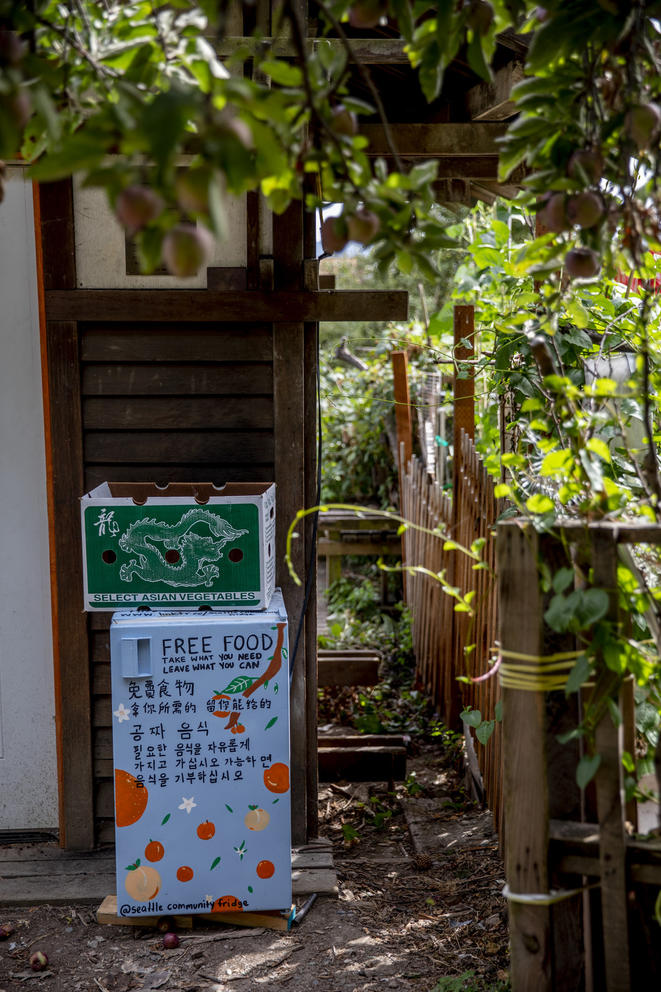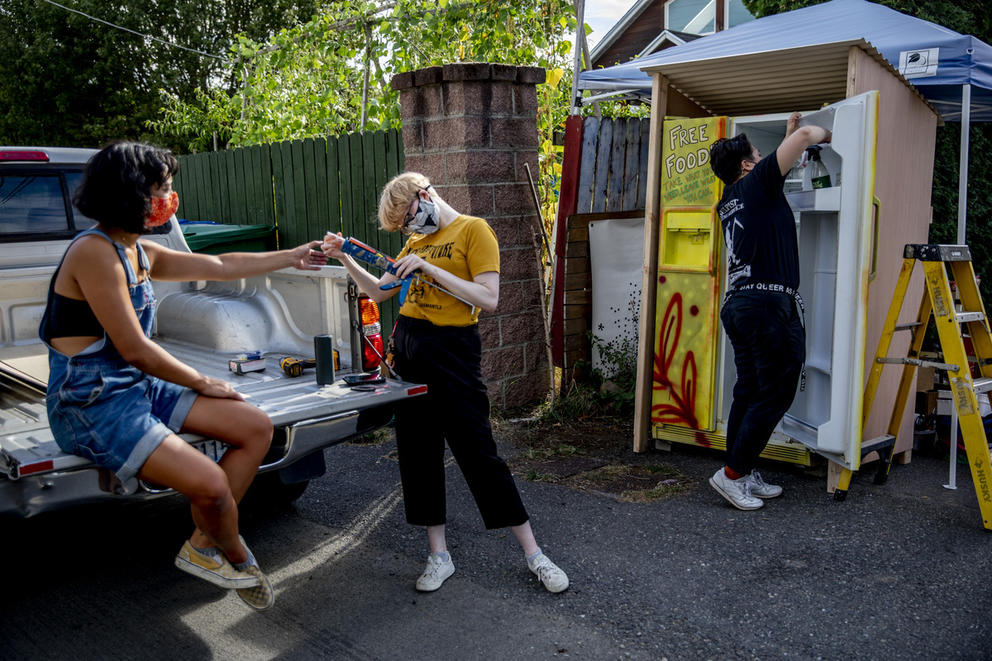The refrigerator, plugged in and nestled in the leafy shade of Seattle’s Danny Woo Community Garden, is part of a new, citywide network of so-called “community fridges.” Taking after similar projects in New York, Oakland, San Francisco, Milwaukee and other U.S. cities, a local group of volunteers installs and stocks the fridges as a way to get free, fresh food and produce to people who may need it, no questions asked. Amid rising food insecurity, this literally cool food pantry can keep produce and other surplus food donated by volunteers — eggs, bread, yogurt — fresh for longer.
“We all need food, and we all deserve it,” says Christina Charlton, one of the Seattle Community Fridge’s volunteers. Plus, there's plenty of it, says Jordan Saibic, another volunteer. “A lot of people don’t have access to food, [but] there is actually so much food that is thrown away, either from restaurants or grocery stores,” Saibic says.
Charlton and Saibic kickstarted the Seattle mutual aid project this summer with a fellow organizer, Dre Bean, after seeing Instagram photos of friends setting up brightly painted refrigerators on sidewalks in New York (where some call them “Friendly Fridges”) and in Los Angeles.
Since then, the group has grown to 10-plus members and set up three working fridges, the one in the Danny Woo garden in the Chinatown-International District and two in the South Park neighborhood. There are at least four more in the works for locations in Beacon Hill, West Seattle and North Seattle.
Community fridges are not a completely novel concept. Some say the idea originated in Berlin, nearly a decade ago, and volunteers have operated nonrefrigerated free pantries in the U.S. for a while. But ever since COVID-19 put millions out of a job and pushed food insecurity rates in the U.S. to record levels, neighbors have been pitching in. Some have turned “Little Free Libraries” into “Little Free Food” pantries. Others have joined the international network built on a cooler cousin, the fridge (the California-based nonprofit “Freedge" is mapping the rapidly increasing locations).
In King, Pierce and Snohomish counties, food insufficiency rates have nearly doubled since the start of the pandemic, with one in 10 residents reporting not having enough to eat. People of color have been especially hard hit.
“Access to food and [other] economic issues are really exacerbated by COVID-19 and the economic consequences of it,” Saibic says. “Mutual aid networks like this are getting a lot more traction, and a lot more people involved, because they’re realizing that at any point they can be put in a position where they don’t have access to food.”
Just as in other cities, the Seattle fridges are powered by the community. Literally, because someone has to pay for the wattage of a functioning fridge in their front yard, garden or driveway. Figuratively, too, given that the group relies on donations (of refrigerators and food) and volunteers to get them to the right place at the right time.
The group sources most of the fridges from people who’ve signed up to donate online (or reached out via Instagram) and local “Buy Nothing” Facebook groups. Volunteers and local artists then paint them with bright colors and slogans in Spanish, English, Chinese and other languages, depending on the fridge's location.
To oversee the complex operation, Seattle Community Fridge commandeers a giant, color-coded spreadsheet full of planned donations and volunteers who have signed up to host, drive or stock food.
One of those early volunteers was Lashanna Williams, who now has a French-door fridge (painted yellow with floating red flowers, by artist Emma Kates-Shaw) on her front lawn in South Park. A recent peek inside revealed tofu, cartons of eggs, carrots, lettuce, berries and organic yogurt and milk. “The fridges are there not only to address the immediate need of food and nutrients for people,” Williams says. “It’s also a physical reminder that your neighborhood cares.”
On a sweltering August day, three Community Fridge volunteers built a shed to shelter the South Park fridge from future rain. Behind it, a table held a load of fresh vegetables — including some oversized zucchinis from someone’s garden — plus canned foods and sanitary pads, all free for the taking. Most of the food came from neighbors, Williams says, who either bought extras on their weekly grocery run, couldn’t eat all the vegetables grown in their garden or just had some food they couldn’t get to. (But heed this advice: “If you wouldn’t eat it yourself, don’t put it in the fridge.”)
Like Williams, the donors are often solo citizens stocking the community fridges with whatever they have left or want to contribute. Local groups like Food Not Bombs, a longstanding free meal collective, and Pedaling Relief Project, a farm-to-city and food donation cycling collective, contribute fresh produce, bread and other perishable foods semiregularly. A local grocery store and food bank have also donated frozen food, Saibic says.
Sometimes food banks don’t have the capacity to store all the perishable food that comes to them, says Maddie Price, another Community Fridge volunteer who works at a hunger-relief nonprofit as her day job. “There’s a need to keep up the flow of food through the emergency food system so that it does [get to] an end consumer before becoming food waste,” Price says. “Community fridges offer a very unique solution to that.”
The fridges also fill another role: bringing (surplus) carrots, zucchini and other produce grown on local farms or in private gardens to people who don’t regularly have this type of food, Price adds. Instead of fresh produce, lower-income households will often spend their limited funds on less expensive, nonperishable foods such as rice and canned goods. “Healthily grown food should be the default for everyone,” Price says. “Because it's not just [about] food security, it's nutrition security.”
Plus, Saibic says, unlike food banks, community fridges are available 24/7 and are largely anonymous. “If we can get fridges directly in communities where people don’t have to jump through any hoops of applying for things or having access to a computer, where they can just walk out on the street and grab the food that they need — it’s one less barrier.”
While the group doesn't know who has been making use of the fridges (part of the point is anonymity), Saibic says they regularly need restocking. “I have seen photos of the fridges before they stock it, and noticed that a couple of days after a major restock it's ... ready for another,” Saibic says.
With a small footprint, Seattle Community Fridge members know the project can’t entirely solve hunger or food insecurity. “It’s one piece of a whole system that’s needed,” volunteer Charlton says. But, she says, if a small collective can help, everyone can. The group is not a nonprofit or foundation, she points out. “We’re just regular folks that were like, this is something that we have the capacity to do, and there’s a need for it,” Charlton says. “So let’s just do it.”
Get the latest in local arts and culture
This weekly newsletter brings arts news and cultural events straight to your inbox.








